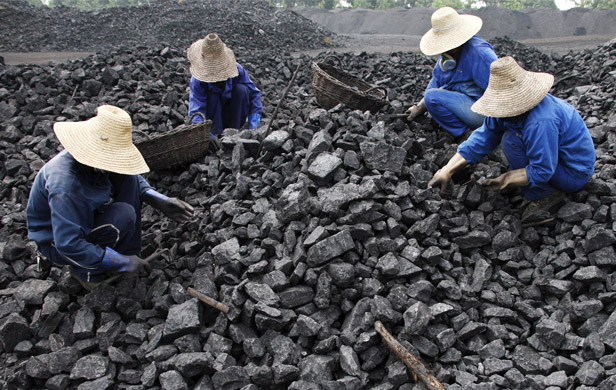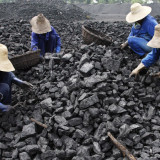
by Jonathan Fahey
NEW YORK – The future of coal is getting darker.
Economic forces, pollution concerns and competition from cleaner fuels are slowly nudging nations around the globe away from the fuel that made the industrial revolution possible.
The U.S. will burn 943 million tons of coal this year, only about as much as it did in 1993. Now it’s on the verge of adopting pollution rules that may all but prohibit the construction of new coal plants. And China, which burns 4 billion tons of coal a year — as much as the rest of the world combined — is taking steps to slow the staggering growth of its coal consumption and may even be approaching a peak.
China: The beginning and end of coal
Michael Parker, a commodities analyst at Bernstein Research, calls the shift in China “the beginning of the end of coal.” While global coal use is almost certain to grow over the next few years — and remain an important fuel for decades after that — coal may soon begin a long slow decline.
Coal has been the dominant fuel for power generation for a century because it is cheap, plentiful, and easy to ship and store. But it emits a host of pollution-forming gases and soot particles, and double the greenhouse gas emissions of its closest fossil fuel competitor, natural gas. Now utilities are relying more on natural gas to generate electricity as discoveries around the world boost the fuel’s supplies. The big, expanding economies of China and India are building more nuclear and hydro-electric power plants. Renewable energy sources such as wind and solar, while still a small fraction of the global energy mix, are growing fast as they get cheaper. And a greater emphasis on efficiency is tempering global growth in electricity demand.
U.S. coal consumption lowest in 20 years
In the U.S., coal production is on track to fall to a 20-year low of just over 1 billion tons this year. In the first half of the year, 151 U.S. coal mines that employed 2,658 workers were idled, according to a study conducted by SNL Energy, an energy-market data and analysis firm. Last month the U.S. government held an auction for mining rights to a prime, coal-rich tract of land in Wyoming and didn’t attract a single bid.
Later this week, the Obama Administration is expected to announce a rule that would cap the amount of carbon dioxide that new power plants are allowed to emit. The new limits appear to be impossible for coal plants to meet without carbon-trapping technology that analysts say would be prohibitively expensive — if it were even available commercially yet.
The coal industry and energy forecasters have long known that clean-air rules and competition from natural gas would make the U.S. a tough market for coal. But they predicted that rising coal demand in Asia, and particularly China, would more than make up for the slowing U.S. demand and power strong growth for coal companies for years to come.
China’s coal demand to peak by 2020
Now even that last great hope for coal may be fading. In a report published earlier this month Citibank analysts suggested that “one of the most unassailable assumptions in global energy markets” — that coal demand would continue to rise in China for the foreseeable future — may be flawed. Bernstein Research reached similar conclusions in a report published in June.
Both reports predict coal demand in China will peak before 2020. Bernstein researchers predict Chinese demand will top out at 4.3 billion tons in 2015 and begin to fall by 2016. China is far and away the most important country for the world’s coal industry: Between 2007 and 2012, growth in Chinese coal consumption accounted for all of total global growth, according to Bernstein. Without China, world demand fell 1.2 per cent over the period.
[signoff1]
But Chinese economic growth, which averaged 10 per cent for the 10 years ended in 2012, is expected to slow to 5 per cent to 8 per cent over the next decade. At the same time, the Chinese economy is expected to require less energy to grow, and other forms of generation such as nuclear, hydro-electric and renewables are elbowing into coal’s turf. And government officials are responding to public outcry over China’s notoriously unhealthy air. Last week Chinese authorities announced they would ban new coal fired power plants from three important industrial regions around Beijing, Shanghai and Guangzhou.
In the view of Bernstein analysts:
[quote]All industrialized societies eventually decide that, while cheap sneakers are nice, the environmental damage caused by uncontrolled industrial activity is no longer tolerable.[/quote]
If these new predictions come to pass, it would spell more lean times for coal miners in major coal exporting countries such as the U.S., Australia and Indonesia. At the same time, the shift would give a major boost to efforts to curb emissions of carbon dioxide, a greenhouse gas, and pollutants such as mercury and sulfur dioxide.
Cleaner coal too costly?
Outfitting coal plants with scrubbers and other pollution-trapping equipment makes coal-fired power much more expensive and makes other technologies, including renewable power, comparably less expensive.
“The economics, finally, are at our backs,” says Bruce Nilles, who directs the Sierra Club’s Beyond Coal campaign.
Coal industry predicts better days ahead
To the coal industry, this is simply a lull that plagues commodity markets every few years. A global oversupply of coal that developed last year pushed prices dramatically lower and forced companies to cut back. That glut is now being burned through, the industry says.
Even if economic growth in places like China and India isn’t quite what it was over the last decade, it will still remain strong enough to keep global demand rising for many years, some analysts and industry executives say.
Says Vic Svec, investor relations chief at Peabody Energy:
[quote]Coal has several decades of long-term growth ahead of it.
[/quote]
Peabody, which is the world’s largest investor-owned coal producer, predicts that between 2012 and 2017 the world will need an additional 1.3 billion tons of coal per year — one-third more than the entire U.S. consumes in a year.
“Maybe today (Asia) doesn’t need our coal because there is over-supply and lower prices, but that will change,” says Michael Dudas, a coal company analyst at Stern Agee.
But a growing number of experts are beginning to reconsider the long-held assumption that the developing world will consume ever more coal just the way the developed world once did.
“The era of wanton Chinese coal demand growth is approaching an end,” wrote Citibank analyst Anthony Yuen.
Jonathan Fahey can be reached at http://twitter.com/JonathanFahey .


The end of coal? Really huh? The King is dead, long live King Coal!
Coal is not dead in fact its peaking and growing. The US not so much, and coal reflects that but BC is proof that apparently coal just might survive, ya know as long as we keep the labour cost down and employ enough foreign temporary workers.
Your points are addressed in the story, Kevin.
The question is not whether coal will be gone tomorrow – it’s what does the future hold for the resource that has been a mainstay since the Industrial Revolution.
As the article states, the U.S. and many other industrialized nations’ coal use is on the decline. China’s use is growing, but slowly – and it’s predicted to peak by 2020.
The story references the predictions of a reputable commodities analyst at Bernstein Research, Michael Parker, who “calls the shift in China ‘the beginning of the end of coal.’ While global coal use is almost certain to grow over the next few years — and remain an important fuel for decades after that — coal may soon begin a long slow decline.”
Couple that with the rapid drop in the price of renewables – many of which are coming close to coal now – plus the increase of shale gas, and it’s clear that coal faces some major challenges as an energy source.
So is coal on the way out tomorrow? Of course not. But in the long run, it will likely be seriously marginalized, which is a good thing (except where it’s replaced by fracking!)